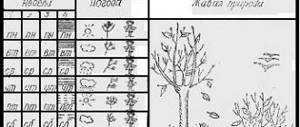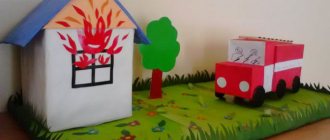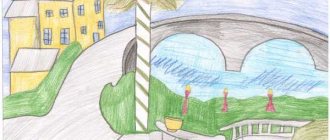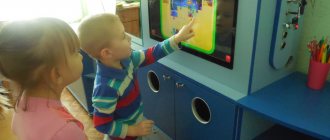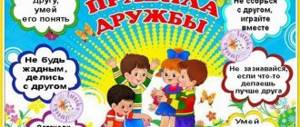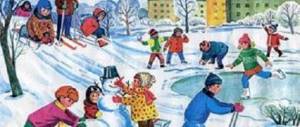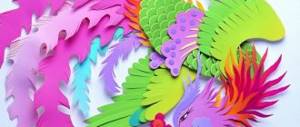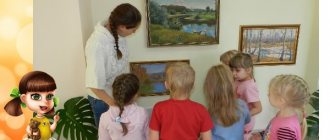A kindergarten is not just a place where a child spends time while parents are at work. Here he receives development, gets acquainted with the rules of communication and behavior, learns a lot of new things about himself and the world around him. The Federal State Educational Standards program states that, among other things, each group must have a nature calendar for kindergarten. For younger children this is one stand, for older children - another. However, such a calendar performs important tasks and serves as teaching material for teachers in introducing children to nature and weather.
Nature calendar for kindergarten - why is it needed?
A corner of nature, as the above-mentioned calendar is also called, is a useful decoration for every group. It should not only be bright and interesting, but also meaningful. Main functions of the calendar :
- Formation of children's ideas about ecology.
- Development of thinking, the ability to establish cause-and-effect relationships between various natural phenomena.
- Instilling the basics of proper behavior in nature and the desire to preserve it.
- Forming an idea of how huge and diverse the world around is.
- Fostering a reverent attitude and love for nature.
Each educator has his own idea of what a natural area should be like. But we should not forget that children should learn as much as possible and in a form that is understandable to them. An addition to the calendar will be a corner of wildlife, where you can place indoor plants (ficus, primrose, violets, chlorophytum and others) and show the children how to properly care for them. You can also get small and unpretentious animals there: fish, pigs, parrots, hamsters, mice, turtles. Children will be able to visually observe how representatives of flora and fauna behave depending on the time of year and weather conditions.
The biggest difficulty for teachers is usually related to the design of a calendar in a corner of nature. Questions about what information to put there, how to present it correctly, how to tell students about what they see. Now in the store you can find a large number of ready-made nature calendars for kindergarten, which contain everything you need. As a result, all options are divided into 2 age groups: for the younger group and the middle/senior group.
For the younger group of kindergarten (from 3 to 4 years old)
However, preschoolers’ knowledge of the surrounding world and natural phenomena is possible not only through observations; modeling activities can be of great help in this. The variety of natural phenomena that make up the immediate environment of children creates the appearance of their easy cognition in the process of observation.
By carrying out this work, you can observe the growth and development of radishes, cucumbers, and onions. Or animals - the growth and development of a hamster in the senior group or the development of chickens and their relationship with the chicken in the preparatory group. Maintaining such a calendar can be done in the following ways. Let's consider them using the example of observations of radish growth (Fig. 1.1).
However, preschoolers’ knowledge of the surrounding world and natural phenomena is possible not only through observations; modeling activities can be of great help in this. The variety of natural phenomena that make up the immediate environment of children creates the appearance of their easy cognition in the process of observation.
With the help of a teacher and an observation calendar, children will learn to notice changes in nature: it becomes colder, it rains, birds fly away to warmer climes; learn to recognize and name the seasons.
It was quiet in the forest, the trees were dozing (raise your arms up, Then the wind blew, and they trembled to rise on their tiptoes) The wind mercilessly broke them at times (movement of the hands from side to side; arms extended, leaning left, right, forward) They sat under a tree the guys in a crowd (squats) Waited for the bad weather to subside. And again, as before, there is silence.
Placing fresh flowers to consolidate knowledge about herbaceous and indoor plants (impatiens, ficus, chlorophytum, geranium, begonia, primrose, etc.); learning how to care for them.
Observations are carried out over a long period of time. Children get acquainted with the features of an aquarium, where there is soil and pebbles. Fish and plants need light, the water should not be very cold. The series of observations that we conduct with children includes a separate detailed examination of each component that is included in the aquarium and its significance.
Each educator has his own idea of what a natural area should be like. But we should not forget that children should learn as much as possible and in a form that is understandable to them.
Nature calendar for the younger group
For children 3-4 years old, there are several types of nature calendars: observation of the growth and development of animals, birds, seasonal changes in nature. The calendar about birds contains photographs of different birds that fly to the feeder - children are meeting many of them for the first time.
The calendar of changes in nature depending on the season allows children to systematically observe what is happening outside the window every day and compare it with the data. Very often it is designed in the form of a clock with an arrow. The teacher needs to conduct observations for them at the beginning and end of each season. Attached to the calendar are pictures depicting weather conditions at different times of the year, so after the walk the entire younger group can find the necessary ones (sun, rain, wind, snowstorm) and attach them to the stand. In this case, the calendar may contain several sectors:
- Seasons: summer, spring, autumn, winter. In any case, a nature calendar for a kindergarten should be designed with this sector, because in the younger group, children begin to have an idea of what it is cold, hot, windy, whether this refers to spring or autumn, winter or summer, whether birds fly away or are returning.
- Natural phenomena and temperature: rain (strong and weak), snow, blizzard, wind, sun, fog, hail, frost, ice, etc.; temperature scale with an element moving along it.
- Days of the week: Monday to Sunday.
At the same time as using the nature calendar, the teacher gives the children a didactic game where they need to properly dress a doll for a walk. They must understand how warm clothes need to be selected, where and in what order they should be worn.
Outline of maintaining a nature calendar with older children
Daria Churakova
Outline of maintaining a nature calendar with older children
Entering the calendar . At the end of the second week of September (Friday)
The teacher introduces
two calendar pages to the group : “Symbols”
and
“September”
.
Shows them to the children and explains that from Monday next week they will begin observing nature . Reviews these pages with the children and explains the symbols. Then he hangs them in a corner of nature .
First observation (Monday)
. Observing the weather. During a walk, the teacher asks the children to observe the weather for about a minute and then answer the following questions: is it cold or warm outside? How are the children dressed? Windy or calm? How do you know if it's windy (or calm? Is it sunny or cloudy? Is it raining or not? Was it raining or not (how did you know that? Will it rain again (how do you know that?)
In the group , after a walk, the teacher takes the children to the calendar , shows them what color and in which column they should paint the “Monday”
, how and with what icons to mark the phenomena that they observed.
Observation two (Tuesday)
.
Observing the weather (carried out in the same way)
. Examining trees: the teacher suggests looking at the trees, remembering what they were like in the summer, saying what has changed and why.
One tree that will be sketched in the calendar is examined in detail: what color are the leaves? Which leaves are there more (green, yellow, red? How are the leaves of different colors located on the tree? Are there many leaves on the tree? Is the sky visible through the leaves? Are there many fallen leaves? What color is the grass? What color are the fallen leaves?
Bushes and flowers intended for inclusion in the calendar . In a group, children independently (but under the supervision of a teacher)
Color in the
“Tuesday”
and mark the weather with icons.
In the evening or the next day, if you are planning a drawing lesson on the theme “Golden Autumn”
, the guys draw a tree, a bush, flowers that they were looking at.
The best drawing is placed in the calendar .
Observation three (Wednesday)
.
Weather observation (carried out in the same way)
.
Comparison of the picture chosen for the calendar with the natural objects depicted on it. Children evaluate the drawing (how accurately the tree, bush, flowers, ground cover are depicted in it)
. The teacher suggests paying attention to the insects that the children see during a walk and remembering them.
In the group, children mark the day of the week and the weather on the calendar. They remember what insects they saw on a walk. Complete the drawing and place it in the column “ Wildlife ”
.
Observation four (Thursday)
. Children on a walk observe the weather, pay attention to insects and birds.
In the group , they independently record the day of the week and the weather in the calendar . The teacher shows how to complement the drawing with images of birds and insects that were seen on a walk.
Observation five (Friday)
. Children watch the weather, the insects and birds they encounter. Looking at the vegetation of the site, one admires the elegant, colorful decoration of the golden autumn.
In the group, the children independently record the day of the week, the weather and complement the drawing with new species of insects and birds.
The teacher gives the task to observe and remember what the weather will be like on Saturday and Sunday. Early next week (Monday)
In their free time, children mark Saturday and Sunday weather on the
calendar .
The teacher discusses with them the results of a week of observations of nature . He conducts a conversation on approximately the following questions:
— What icons did we use to mark the weather and days of the week?
— What was the weather like last week on Monday and Tuesday? How can this be seen from the calendar ?
— What kind of plants have become on the site (trees, bushes, grass?
— Is this visible from the calendar ? Why do plants change?
- What animals (insects, birds)
were you at the site? Birds you saw: wintering or migratory?
Removing the calendar , the teacher reports that the next observations of nature will be carried out in the third week of October. It is very important that for all subsequent observations natural objects are reflected the calendar as the first time. The drawing technique should always be the same (pencil, paint or felt-tip pen)
.
Conclusion
The experience of introducing calendars into the practice of kindergartens has shown: the use of this type of modeling has an intense impact on the development of visual-figurative thinking. Working with the calendar at all stages (filling out, summing up , repeated examinations, comparing similar phenomena) enriches children’s specific ideas, forms a special type of ideas that reflects the process of changing natural in unity with the time parameter. However, the formation of this type of representation is possible only with regular, time-ordered recording of observations. The model thus serves as a means of developing unified spatiotemporal concepts. In addition, when discussing the results of observations, children are forced to compare the phenomena recorded on the pages of the calendar , trace the nature of changes, the relationship of individual components; Thus, they learn to detect temporary and causal relationships and establish the simplest patterns.
Thus, logical thinking develops, and with it, speech inextricably develops. What is meant here is a special, so-called collective form of speech - a conversation between a teacher and a group , when statements are mutually complemented, when the content of the conversation, unified in meaning and complete in form, is created. It should be noted that the calendar is the subject of a logically structured discussion, which contributes to the development of skills to reason, analyze, compare events, and then reflects them in speech (conclusions, generalizations, i.e. serves as a visual means of teaching logical operations.
Nature calendar for middle and high school kindergarten
If with 3-year-old children the teacher observes each natural phenomenon separately, then from 4 years old children are able to perceive 2-3 phenomena at the same time. For example, not only rainy weather, but also windy weather, or not just the blooming of leaves on trees, but also their falling when there is a gust of wind. The nature calendar can be complicated or supplemented.
For example, months with holidays can be filled with corresponding flags or pictures: “March 8”, “New Year”, “Easter” and others. Now you can not only mark the day of the week on which the children came to kindergarten today, but also indicate the current date, month and year.
Calendar manufacturers have begun to produce quite modern models that contain magnets and can act as a board for washable markers. Preschool children who have already mastered letters and numbers can add their notes to it or depict what they see with drawings - or the teacher does this. It turns out to be a kind of observation diary, which can be discussed daily with the students. Calendar styles can be very different: cartoon, sports, plain, funny, with images of children, animals, plants or beautiful nature in the background.
Objectives: Show how you can make a “Nature Calendar” stand with your own hands. Develop a desire to make things and design a stand as you wish. Cultivate aesthetic taste and neatness. Invoke the joy of creativity, satisfaction from the work done. Material: plastic panels, building profile, metal strip, ceiling tiles, transparent thick film, colored paper, pictures of the seasons, “Seasons” poster. For the base of the stand I used plastic panels, which were glued together at the joints for strength with ceiling glue. As a frame I used a building profile, which I also glued to the base with ceiling glue.
Seasons – designed on the ceiling tiles. The arrow is cut from food trays. It is held on with Velcro. By moving it, you can indicate each month and season at the same time.
Weather – I pasted pictures of natural phenomena from the “Nature Calendar” poster on the ceiling tiles. On top there are transparent pockets. Children find the pictures they need and put them in their pockets. And in the red squares, children can use a water-based felt-tip pen to mark weather changes throughout the day (this felt-tip pen can be easily erased). All arrows are held on with Velcro.
Temperature – in the middle of the picture there is a thermometer, along the entire length of which Velcro for clothes is glued. The red Velcro mark can be moved throughout the thermometer to indicate the temperature. You can also mark the weather in degrees in the boxes.
Days of the week – the names of the days of the week are printed on sheets of paper of different colors. Children move the arrow around the circle, identifying the days of the week by color, and those who know the letters can read it.
The numbers of the month are pasted onto a metal strip (perforated aluminum sill), along which a red window with a transparent film moves freely. In the red frame, children mark the desired day of the month.
There are also two windows with transparent pockets. In one you can place a picture depicting the season. In the other, there is a child’s drawing reflecting the time of year. In order to place the sheet horizontally next to the window, plastic clips are glued to hold the design. Very comfortably. The sheet can be placed both horizontally and vertically.
To help children navigate time, there is a clock on the nature calendar. Children can easily identify minute and hour hands, minutes and hours by numbers and counting, and can set the right time.
Having such a nature calendar, you can maximize the activity of children in a corner of nature.
Take heart, colleagues! Imagine! I wish you creative success!
Making a nature calendar for kindergarten with your own hands
If you don’t have the funds to buy a ready-made calendar or your imagination is so strong that you want to realize your ideas in creating it, then with a time investment of about 5-6 hours, you can make a corner of nature with your own hands. Here are some interesting options.
Perhaps the most practical calendar will be the one with a wear-resistant base and excellent tenacity. A great option is a rectangular rug. You can attach pictures and decorations to it using pins. The downside of such a calendar is that it is not very secure. Therefore, it is best to use it in the older group of kindergarten. Let each season of the year be decorated separately.
Spring has come - you can hang appropriate photographs (even of the children themselves), pictures cut out from magazines or postcards. On the Internet you will also find images of weather phenomena for this time of year. You can make a “clock” of days of the week and time of day from colored paper. Or it could just be pictures that are selected using checkboxes.
Another good option is a plywood or PVC base. Then it will be safer to work. Self-adhesive paper will allow you to both decorate your stand and arrange it correctly. Ask creative parents to bring themed cards or handmade interactives from home. A moving thermometer indicator can be made from red and blue locks. Let them close in the middle, and above and below it write down the thermometer readings with the original scale.
A simplified version of the natural calendar will also be interesting. Arrange the seasons clockwise, labeling them with their characteristic weather conditions. Place the arrow in the center. You can attach 4 files to the base and insert images with the seasons into them, and on top, using self-adhesive paper or double-sided tape, attach images of animals, weather phenomena, temperature, and other things.
By designing a nature calendar for a kindergarten, you will allow your students to experience the world around them in its manifestations in the form of precipitation, decrease and increase in temperature, animals and flowers waking up and falling asleep. Make or buy a stand that will be understandable to children. Let them be involved in the process as much as possible: they themselves talk about what they see and feel, answer questions about what picture should be placed and where. Develop the guys - this is the future!
